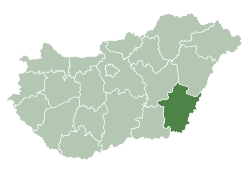Békés (county)
|
Békés County Békés megye |
|||||
|---|---|---|---|---|---|
| Counties of Hungary | |||||
Descending, from top: the Körös near Mezőberény, Arboretum of Szarvas, and Jókai Theater in Békéscsaba
|
|||||
|
|||||
 Békés County within Hungary |
|||||
| Country | Hungary | ||||
| Region | Southern Great Plain | ||||
| County seat | Békéscsaba | ||||
| Government | |||||
| • President of the General Assembly | Mihály Zalai (Fidesz-KDNP) | ||||
| Area | |||||
| • Total | 5,629.71 km2 (2,173.64 sq mi) | ||||
| Area rank | 7th in Hungary | ||||
| Population (2011 census) | |||||
| • Total | 359,948 | ||||
| • Rank | 11th in Hungary | ||||
| • Density | 64/km2 (170/sq mi) | ||||
| Postal code | 55xx – 59xx | ||||
| Area code(s) | (+36) 66, 68 | ||||
| ISO 3166 code | HU-BE | ||||
| Website | www |
||||
Békés County (Hungarian: Békés megye), is an administrative division (county or megye) in south-eastern Hungary, on the border with Romania. It shares borders with the Hungarian counties Csongrád, Jász-Nagykun-Szolnok, and Hajdú-Bihar. The capital of Békés county is Békéscsaba. The county is also part of the Danube-Kris-Mures-Tisa euroregion.
In Slovak, it is known as Békešská župa and in Romanian as Județul Bichiș.
After Hungarians conquered the area, Békés and its surroundings were the property of the Csolt clan. Békés (the name means "peaceful") was originally the name of the castle which gave its name to the comitatus, and, like many castles, was possibly named after its first steward.
This county has a total area of 5,630 km2 (2,174 sq mi) – 6,05% of Hungary.
Békés county lies on the Pannonian Plain (Great Plain), it is a flat area with good soil. Average rainfall is 645 mm/year. One-fifth of the natural gas resources of Hungary can be found in Békés. The river Körös runs through the county.
The area has been inhabited since 5000-4000 BC. Before the arrival of the Hungarians several other tribes lived in the area.
The castle of Gyula was built in the early 15th century. Gyula was the most significant town of the county at that time, and became county seat under Matthias I. It was an important fortress during the Ottoman wars in Europe but it was captured in 1566. During this time, several towns were destroyed in the area.
...
Wikipedia





